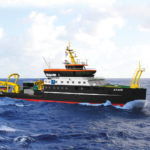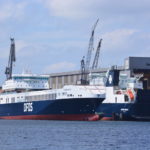Less ships were delivered by German shipyards during 2017. The well-filled order book of numerous shipbuilding companies, however, largely ensures long-term utilization and suggests a positive outlook on the future. By Thomas Wägener
The main competences of German shipyards are still the construction of cruise vessels, mega yachts, naval ships and specialized vessels[ds_preview]. Especially for the latter, additional competition from Asia may be imminent, as Jörg Mutschler, Managing Director of the German Engineering Association (VDMA), announced last November at the 112th Annual General Meeting of the Schiffbau-Technische Gesellschaft (STG) in Potsdam. Thus, the Asians have realized that they cannot live on the construction of cargo ships alone. Accordingly, they want to cast about for additional business areas, and in this context they also target specialized units. German shipyards in special-purpose shipbuilding do not have to fear competition from Asia, yet. However, they intend to closely follow the Asian vessel evolution in this segment, says Mutschler. In order to strengthen shipbuilding in Germany, the Federal Government extended the funding programme »Innovative Shipbuilding Ensures Competitive Jobs« by two years at the end of December 2017 to be effective for another two years. Creating incentives for increased innovation in the German shipbuilding industry is part of the Federal Government’s high-tech strategy. The aim for the shipbuilding industry is to maintain or expand its world market position in highly complex special ships and offshore structures through increased innovation activity, while at the same time securing highly skilled jobs in order to be able to implement innovative solutions.
Less seagoing vessels, more inland ships
Compared to the previous year, the number of seagoing vessels delivered dropped again slightly, while the companies active in the construction of inland vessels have handed over more units to customers than in 2016.
As in the previous year, the Meyer shipyard group delivered two cruise ships built in Papenburg in 2017. In April, »Norwegian Joy« was handed over to Norwegian Cruise Line (NCL), and in October Dream Cruises received the »World Dream«. Meyer Turku Werft, which belongs to the group, also handed over two units to its respective clients last year. In January Tallink welcomed its RoPax ferry »Megastar« and in May »Mein Schiff 6« was transferred from Finland to TUI Cruises. In contrast, the Neptun shipyard, which is also part of the shipyard group, only delivered two units in 2017, unlike in previous years. These were the two river cruise ships »Viking Herja« and »Viking Hild«, which were handed over to long-term customer Viking River Cruises in March.
German shipyards already achieved an excellent reputation in building new megayachts years ago. Accordingly, they will continue to be awarded newbuilding contracts. In 2017, Abeking & Rasmussen delivered the »Aviva«, at almost 100m their largest mega-yacht to date, which was chosen by HANSA to be »Ship of the Year 2017« (see p. 30).
Last year Lürssen Group handed over four mega yachts. Two of them, »Amadea« and »Al Lusail«, were constructed at the headquarters in Bremen-Vegesack, while »Areti« and »Aurora« came from Lürssen-Kröger Werft near Rendsburg. In September Lürssen Group secured a minority share in the Norwegian Kleven Verft together with a group of investors. The sailing yacht »A«, built by German Naval Yards in Kiel, was also completed and handed over to its owner by contractor Nobiskrug in March.
There is momentum in German naval shipbuilding, too. However, the F222 frigate »Baden-Würtemberg«, which had already been handed over to the German Navy, was returned to its construction yard because of deficiencies in the software and hardware of the command and combat system. In addition, difficulties arose with the new radar system and shipbuilding defects on bulkheads and hull were objectionable. The Navy then refused commissioning and the Hamburg shipyard Blohm+Voss was prompted to fix the problems.
Thus, the three-billion-project »F125« with a total of four units has come to a standstill again. The frigate »Baden-Württemberg«, which was built for a six year period, is now scheduled for a longer berthing time in Hamburg, a Federal Office for Equipment spokesman of the Bundeswehr confirmed. Extensive functional evidence at sea had not been provided.
Pella Sietas hands over first newbuilding
Meanwhile, Pella Sietas shipyard celebrated its premiere last year and handed over its first newbuilding after the takeover by the new owner. This was a prototype for Hamburg-based Hadag. In May, the ferry accommodating almost 400 passengers was christened »Elbphilharmonie«. The yard’s first two newbuildings, the river cruise ships »Crystal Bach« and »Crystal Mahler« were also delivered by MV Werften Wismar.
The two core competencies of German inland shipyards remain the construction of passenger ships and design of work boats. Several units of various shipbuilding companies were handed over last year.
Growth of the order book
The order books of German shipyards are mostly filled encouragingly well. The shipyard group Meyer calculates a capacity utilization and long-term secured employment until 2023. Clients, thus, rank among almost all large cruise liners of the world. In 2017, the shipbuilder established new standards in the industry, especially with regard to environmental technologies. According to the company, twelve cruise ships with gas propulsion are currently in the order book. It is said that intensive research is being done on fuel cell technology and other technical innovations for passenger ships.
After Viking River Cruises received »only« two river cruise ships from Neptun shipyard last year, at the same time the Americans ordered six units of the popular longship class to be delivered in the first quarter of 2019. Thus, the new LNG tanker »Coral Energice« for Anthony Veder and the almost 76m long ferry »Norderaue« commissioned by Wyker Dampfschiffs-Reederei Föhr Amrum are the only two ships Neptun has planned to deliver this year.
MV Werften Wismar plans to hand over river cruise ships number three and four to Crystal River Cruises this year. This completes the commissioned quartet. In addition, the construction of the »Crystal Endeavor«, the first of three luxury expedition yachts, has started in mid-January. The prototype is considered the world›s largest megayacht with ice class.
The order book of Lürssen Group is also full. It is always difficult to get detailed technical information on specific yachts and projects as there are usually declarations of secrecy between shipyard and customer. But observers of the market and expert report on numerous projects.
The largest order in the naval business was secured by a consortium consisting of Lürssen, German Naval Yards and ThyssenKrupp Marine Systems (TKMS). The German Navy placed an order for a total of five corvettes. In August, the Federal Cartel Office granted the approval for the order which had already been planned for some time. Initially, the contract was awarded to Lürssen Group and TKMS. Following a successful lawsuit by German Naval Yards, the company is now completing the consortium.
Flensburger Schiffbau-Gesellschaft (FSG) was pleased to receive several orders shortly before Christmas. In the beginning of December 2017, the parent company Siem from Norway initially placed an order for the construction of two RoRo vessels, and shortly thereafter the shipbuilding company signed a contract with the Irish Continental Group (ICG) for a new RoPax ferry. Meanwhile, another contract from Australia is on the horizon. The TT-Line Company wants to build two passenger ferries in Flensburg, a letter of intent has already been signed.
Fassmer shipyard is also experiencing anything but lack of work. Based in Berne at the Unterweser river, the yard continues the construction of lifeboats for the German Maritime Search and Rescue Service (DGzRS) this year. In addition, a nearly 44m long fire-fighting boat destined for Hamburg Port Authority (HPA) is scheduled to be finalized this year, to be complemented by three 86m vessels for the Federal Police.
In December 2017, Hadag ordered a second passenger ferry from Pella Sietas, to be delivered in September this year. It will be a sister ship to »Elbphilharmonie«. Furthermore, the completion of a dredger is expected at the end of 2018.






















